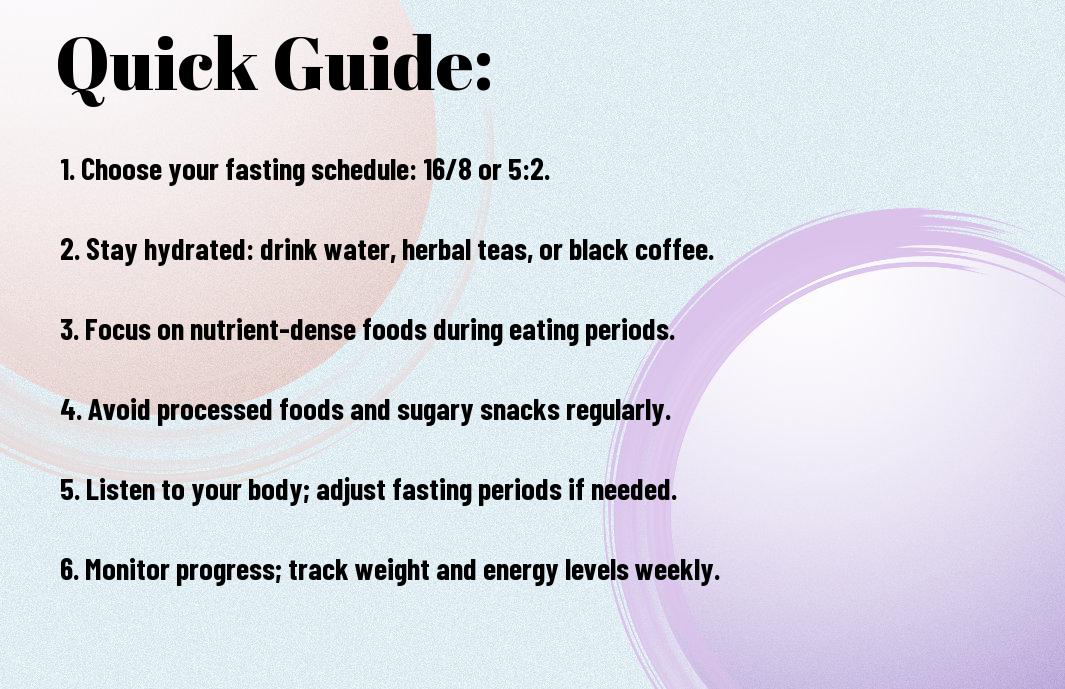Many people are turning to intermittent fasting as a viable option for weight loss and overall health improvement. In this guide, you will explore the basics of intermittent fasting, its benefits, and how to implement it into your daily routine. You’ll learn about different fasting methods, meal timing, and imperative tips to make your journey successful. With the right approach, intermittent fasting can be a powerful tool to help you achieve your weight loss goals while enhancing your wellness.
Key Takeaways:
- Intermittent Fasting (IF) is a dietary approach that cycles between periods of eating and fasting, promoting weight loss by controlling calorie intake.
- Common Methods include the 16/8 method, where you fast for 16 hours and eat during an 8-hour window, and the 5:2 diet, which involves eating normally for five days and restricting calories on two non-consecutive days.
- Health Benefits extend beyond weight loss, with studies suggesting improvements in metabolic health, reduced inflammation, and enhanced brain health associated with intermittent fasting.
- Meal Planning is important for success; focusing on nutrient-dense foods during eating periods helps ensure you meet your nutritional needs while fasting.
- Listen to Your Body and adjust the fasting protocol that works best for you, as individual responses to fasting can vary significantly.

Understanding Intermittent Fasting
A comprehensive understanding of intermittent fasting can help you achieve your weight loss goals. This dietary pattern alternates between periods of eating and fasting, which can lead to several health benefits, including weight loss and improved metabolic health. By choosing to restrict your eating time, you allow your body to utilize stored fat for energy during fasting periods, aiding in weight loss.
Types of Intermittent Fasting
There are several popular approaches to intermittent fasting. Each method can cater to different lifestyles and preferences:
- 16/8 method: Fast for 16 hours and eat during an 8-hour window.
- 5:2 diet: Eat normally for 5 days and limit calories to 500-600 for 2 days.
- Warrior diet: Eat small amounts during the day and consume one large meal at night.
- Alternate-day fasting: Alternate between fasting days and eating days.
- Eat-Stop-Eat: Involves 24-hour fasts once or twice a week.
After identifying the type that suits you best, you can align it with your weight loss journey.
How Intermittent Fasting Works
Assuming you choose to start intermittent fasting, this method works by shifting your body’s energy reliance from glucose to fat. When you fast, insulin levels drop, making it easier for stored fat to be released and utilized for energy. Additionally, fasting initiates cellular repair processes that can enhance your overall metabolic health (your body’s ability to burn fat efficiently is key).
Understanding the mechanisms behind how intermittent fasting works involves recognizing how your body reacts during fasting periods. Instead of relying solely on calories consumed, your body repairs itself and regulates hormones to facilitate fat burning. This approach can lead to effective weight loss and health improvements (finding the right fasting approach can significantly impact your success).
Step-by-Step Guide to Getting Started
Clearly, beginning your intermittent fasting journey is simple when you follow a structured approach. This guide breaks down important steps to help you succeed:
| Step | Description |
|---|---|
| 1 | Learn about different fasting methods. |
| 2 | Choose a fasting schedule that suits your lifestyle. |
| 3 | Plan your meals around your fasting periods. |
| 4 | Stay hydrated during fasts. |
| 5 | Monitor your progress and adjust as needed. |
Choosing the Right Fasting Schedule
Even with various fasting plans available, it’s vital to select one that aligns with your routine. Options like 16/8, where you fast for 16 hours and eat within an 8-hour window, or 5:2, where you eat normally for five days and restrict calories for two, cater to different preferences. Assess your daily schedule and energy levels to determine which plan you can consistently follow for optimal results.
Preparing for Your First Fast
While the idea of fasting may seem daunting, proper preparation can make it an easier experience. Start by choosing a day when you can focus on hydration and nutrition. Stock up on healthy foods to eat during your eating window and familiarize yourself with what to expect during fasting periods. This proactive attitude will set you up for success as you initiate on your intermittent fasting journey.
Guide yourself through the process by planning your meals meticulously. Avoid heavy meals right before fasting, as they can lead to discomfort. Instead, opt for balanced meals rich in protein, healthy fats, and fiber to keep you feeling satisfied longer. Additionally, inform your friends or family about your fasting schedule so they can support you and understand your plan better. This way, you will feel empowered and ready to tackle your first fast with confidence.
Tips for Success
Once again, to achieve your intermittent fasting goals, keep these tips in mind:
- Set realistic fasting windows that fit your lifestyle.
- Start slowly by incorporating shorter fasting periods.
- Plan your meals ahead of time to avoid impulsive eating.
- Listen to your body and adjust your approach as needed.
The key is to find what works best for you.
Staying Hydrated
To maximize your fasting success, staying hydrated is crucial. Drink plenty of water throughout the day, and consider herbal tea or black coffee during fasting windows to help curb your appetite. Staying well-hydrated not only supports your overall health but can also help mitigate hunger pangs.
Managing Hunger and Cravings
Assuming you experience hunger and cravings during your fasting windows, it’s important to know that these feelings are normal. Focus on healthy, satiating meals during your eating periods that include plenty of protein and fiber to keep you full. (Finding healthy snacks that align with your fasting plan is a beneficial step.)
Success in managing hunger and cravings lies in understanding your body and developing effective strategies. You may benefit from journaling your food intake and emotional responses to identify triggers and improve your relationship with food. (Consider meal prepping to eliminate spontaneous choices that may lead to breaking your fast.)

Factors Influencing Weight Loss
Despite your efforts in intermittent fasting, several factors can influence your weight loss journey, including:
- Your dietary choices
- Your metabolic rate
- Your physical activity
- Your stress levels
- Your sleep quality
Assume that embracing these variables will help you create a more effective weight loss plan.
Individual Metabolism
There’s a significant variation in individual metabolism that impacts how quickly or efficiently you can lose weight. Your metabolic rate is influenced by factors such as age, genetics, and muscle mass. (Evaluating your metabolism can help tailor your approach to fasting for optimal results.)
Activity Level and Exercise
On the other hand, your physical activity plays an necessary role in weight loss. Engaging in regular exercise not only helps to burn calories but also enhances your overall metabolic rate, helping you achieve your weight loss objectives more effectively.
Level of activity can significantly affect your success with intermittent fasting. By incorporating both aerobic and strength training exercises, you can maximize calorie burn and improve your muscle tone. Strive to find a balance between your fasting schedule and exercise routine to fuel your body efficiently while working towards your weight loss goals.
Pros and Cons of Intermittent Fasting
For anyone considering intermittent fasting, understanding the pros and cons is imperative to making an informed choice. While it can offer various health benefits, it’s important to be aware of potential drawbacks that may affect you.
| Pros | Cons |
|---|---|
| Improved weight loss | Hunger and cravings |
| Enhanced metabolic health | Possible nutrient deficiencies |
| Convenience | Social challenges |
| Increased focus and energy | May not suit everyone |
| Potential longevity benefits | Disruption of routine |
Benefits of Intermittent Fasting
Pros of intermittent fasting include enhanced weight loss, improved insulin sensitivity, and greater mental clarity. By limiting your eating window, you may find it easier to control calorie intake, leading to successful weight management.
Potential Drawbacks
If you decide to try intermittent fasting, be aware of potential drawbacks such as extreme hunger, irritability, or nutrient imbalances. (It’s important to evaluate how this method aligns with your lifestyle and personal preferences.)
Understanding the potential drawbacks can help you make a wise decision regarding intermittent fasting. Some individuals may struggle to maintain focus or a social life while adhering to fasting schedules. (Consider your daily activities and whether intermittent fasting fits into your overall wellness strategy.)
Common Mistakes to Avoid
After starting your intermittent fasting journey, it’s important to recognize that some common pitfalls could hinder your weight loss success. Many individuals make mistakes that disrupt their progress, leading to frustration and discouragement. By being aware of these errors, you can maximize the effectiveness of your fasting routine and stay committed to your goals.
Overeating During Eating Window
An imperative factor to successful intermittent fasting is the food choices you make during your eating window. Overindulging in high-calorie meals after fasting may counteract your weight loss efforts. (Prioritize balanced meals rather than treating it as a free-for-all.)
Ignoring Nutritional Quality
Clearly, it’s vital to focus not only on when you eat but also on what you eat. Ignoring the quality of your meals can lead to the intake of empty calories that lack imperative nutrients, affecting your overall health and weight loss goals.
Overeating highly processed foods may seem appealing during your eating window, but these items often lack nutritional value and can trigger cravings. Instead, prioritize whole foods like fruits, vegetables, lean proteins, and healthy fats. This approach will not only support your weight loss efforts but also enhance your energy levels, mood, and overall well-being.
To wrap up
To wrap up, intermittent fasting can be an effective strategy for your weight loss journey, promoting a healthier lifestyle while enhancing your metabolic health. By understanding the different methods, you can choose the approach that best fits your routine and preferences. As you begin on this journey, listen to your body, stay mindful of your eating habits, and ensure you maintain a balanced diet during your eating windows. With patience and consistency, you can achieve your weight loss goals and improve your overall well-being.
FAQ
Q: What is intermittent fasting and how does it aid in weight loss?
A: Intermittent fasting (IF) is an eating pattern that alternates between periods of fasting and eating. It doesn’t prescribe what to eat but rather when to eat. This approach can help manage calorie intake, as it often leads to fewer meals consumed during the day. Additionally, fasting periods can enhance metabolic processes, such as fat oxidation and insulin sensitivity, which can contribute to weight loss over time. Various methods of intermittent fasting include the 16/8 method, where you fast for 16 hours and eat during an 8-hour window, or the 5:2 method, where you consume a limited number of calories for two days a week and eat normally on the other five days.
Q: Are there any specific foods I should eat while following an intermittent fasting regimen?
A: While intermittent fasting focuses more on timing than specific foods, choosing nutrient-dense foods during your eating windows can enhance your weight loss results. Prioritize whole, unprocessed foods like lean proteins (chicken, fish, legumes), healthy fats (avocados, nuts, olive oil), and a variety of fruits and vegetables. These foods can help you feel fuller longer and provide vital nutrients that support overall health. It is also beneficial to stay hydrated by drinking water, herbal teas, or other non-caloric beverages during the fasting periods.
Q: Is intermittent fasting suitable for everyone, and are there any potential risks involved?
A: Intermittent fasting can be beneficial for many individuals, but it may not be suitable for everyone. People with certain medical conditions, such as diabetes, or those who are pregnant or breastfeeding should consult a healthcare professional before starting any fasting regimen. Additionally, individuals with a history of eating disorders may find that fasting triggers unhealthy eating behavior. It’s vital to listen to your body and remain mindful of how fasting affects your energy levels and overall well-being. If you experience negative side effects, consider adjusting your approach or seeking advice from a nutrition expert.










Reply